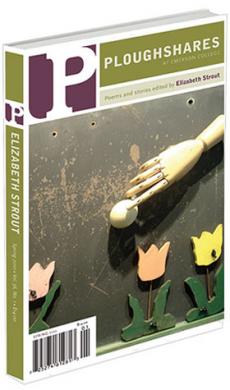Rev: The Art of Syntax: Rhythm of Thought, Rhythm of Song
Robert Frost advises that the surest way to reach a reader’s heart is via the ear; Ellen Bryant Voigt, in her illuminating contribution to Graywolf’s "The Art Of" series, maps out the cerebral pathways along the ear-to-heart journey. A gifted poet and teacher, Voigt has long been masterful at breaking down–and thus building up–the music and thinking in lyrical expression (see, too, an earlier volume of essays, The Flexible Lyric). It’s a pleasure to reencounter her vigorous eye and intellect as she contemplates syntax, the order of words in a sentence: not merely the grist for utilitarian, discursive communication, but rather the expressive organization of sound and music that engenders an intelligent love of poetry. Highlighting common syntactical patterns and their musical arrangement, exploring how poetic lines interact with sentences, and illustrating how phrasing can balance or undermine meter, relax or propel pacing, and score unfolding narratives, Voigt reveals a detailed topography of conjoined music and meaning.
Tackling the intramural activities of line and syntax is particularly complex and far from the "singular" issue that the series précis suggests. One notes, too, that a heady sibling volume, The Art of the Poetic Line, from James Longenbach, adeptly covers similar ground. That said, the insight that these two fine poets bring to bear yields a delightfully geeky intellectual pleasure: we poets enjoy considering whether lines are end-stopped or end-paused, whether enjambments are annotated or parsed, dissonant or consonant. If these aren’t your foremost pleasures, hang in there. Even within the targeted milieu of writers and teachers, Voigt’s rigorous grammatical fidelity–dallying with plosive consonants and copulative verbs here, objective and dative cases there, a slight obsession with the altar of subject and predicate–runs the risk of stalling. It serves, however, to chaperone an inviting complex of references, including theories on language acquisition from Piaget and Chomsky, musicology via Robert Jourdain, and the close reading of various poems. Thus, the only caveat emptor: patient reading, echoing the care and precision of its author’s work, is necessary. As with a good lyric, you’ll need to return to this compact volume and revisit its compelling pleasures.
Thankfully, her analysis of "elaborate but comprehensible structures" is buoyed by her appetite for and acuity with language. In particular, her figurative gifts and keen juxtapositions keep this uber-textbook lively. It’s no easy task to make grammar appetizing, but Voigt finds the right seasoning. Whenever a specialized lexicon threatens to evoke the mind-glazing, post-lunch torpor of afternoon grammar lessons, Voigt finds a pithy image or figure to ground the writing: thus, when speaking of subject-verb-object placement within a vast genealogy of sentence types, she likens syntactical patterns to a train engine that might appear "almost anywhere in the sentence, pushing some of its boxcars and pulling others." Seminal moments like these–as when she notes that memorable rhythm is "muscular, not merely skeletal"–anchor ideas with fresh and tangible figures. And she’s witty too, as when she parries Frost’s dictum about free verse as tennis with the net down with Charles Wright’s idea that free verse is actually "the high-wire act without the net," or notes how syllabic measure may number the "pieces of fruit in the bowl" yet "fails to distinguish grapes from bananas." Humor and candor nicely supplement her analysis.
At her best, Voigt takes us through a poem both intellectually and kinetically, as when she recalibrates the syntax of poems by Stanley Kunitz and D. H. Lawrence, showing us an original’s patterned effects by revealing what different lineation wouldn’t accomplish–a kind of demolition that highlights the integrity of an original structure. Thus Voigt gives us an original version of a Stanley Kunitz line,
If the heart were pure enough,
but the heart is not pure
and an altered version,
If the heart were pure enough, but the heart is not pure
in order to show how the short, parsing line–contextualized in a "series of assertions, sometimes thorny, sometimes breezy, [with] moments of sly reversal and qualification"–works more effectively than if the poet had chunked "logical parentheticals alongside his conditionals," thereby canceling out "units of thought" and "undermining the authority of the voice."
Other highlights include an enlightening choreography of Shakespeare’s Sonnet 29. Voigt clearly outlines the mounting power of the poem’s dominant periodic sentence and reveals how the formal muscle of meter mainly serves to reinforce the sentence:Shakespeare "puts syntax in charge" and keeps the instrumental grid of meter more muted. Voigt then presents a valuable counterpoint of a poem, Philip Larkin’s "The Trees," and shows how its accentual-syllabic music takes center stage, its more variable sentence sounds barely discernible, a "small ripple on the foregrounded formal surface." With the rhythms of song (line) and the rhythms of thought (syntax) working separately and simultaneously–as with the hands and feet in basketball, "both at their own task"–the potential yields are marvelously flexible, "the language ordinarily spoken by human beings…intensified by the echoes of more regular and regulated patterns of song."
With flexible approaches to music in mind, Voigt contemplates the relaxed accentual patterns of Elizabeth Bishop’s "The Moose" and syllabics in Donald Justice’s work, finding nuanced layers of thinking afforded by more complex syntactic variation. Supplying her own versions of Bishop’s drafts, with boldface type to indicate omitted words and italics for handwritten insertions, Voigt shows how Bishop discovered her braided rhythms through drafts of "trial and error"–an important inclusion, lest Voigt’s thorough analysis suggest a poet’s fully conscious address of all issues syntactic as one composes. In addressing writerly intent, Voigt, with a wink and nudge, lauds the "sometimes instinctive, sometimes fretted over preferences" that poets make in both the heat of composition and the cooler reflections of revision, weddings of the "analytical…and the intuitive."
Voigt concludes with a timely comment about aesthetics, dismantling any fears about how a book with formality and structure at its core might jibe with current de rigueur tastes of asymmetry and variation. Citing Apollo and Dionysus as well-matched opponents, Voigt suggests that wherever we wager our poetic chips–on "pattern over variation, or energy over order, or, currently, fragmentation and disjunction over unity and coherence"–it remains that the best players will "petition both deities." Voigt’s larger concerns with poetic evolution out of structural wellsprings allows for a variety of aesthetics as poets swim with, against, and inside the syntactical currents of English.

